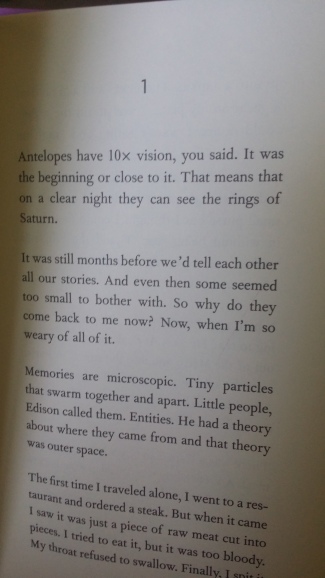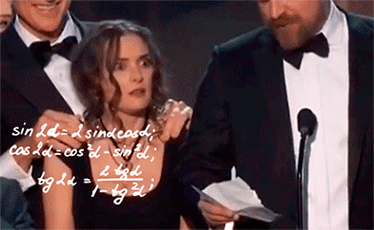I cannot believe that my group is on our final book already. (Where has the time gone?!) For our last group of blogs, we decided to read Dept. of Speculation by Jenny Offill. Although this book falls under the genre of fiction, we see that its form is a bit unconventional; Experimental to say the least. As you can see in the example below, the short chapters are broken up into little paragraphs that has little to no organizational order.

I must admit that it took me awhile to adjust to this new form of writing, but by the third chapter it was all starting to fall into place. What occurred to me, at first as random unrelated thoughts, soon started to form a visible pattern. By stepping back and treating each paragraph as its own entity, I was able to decipher the meaning of the paragraphs individually, as well as altogether. As I continue reading this book, I keep reminding myself that the narrator is telling this story as a stream of conscious. So it would only be fitting that the chapter would be sporadically composed, because it is realistic to how our minds think throughout the day. We usually do not think in clear, concise patterns, but instead we experience a million random thoughts one after another.

In Dept. of Speculation, we are in the mind of our narrator who is thinking back to all the things that have become her life. In a sense, we are joining her in reflecting on the rollercoaster ride of life. She is an artist, who after marrying her husband and having an unplanned baby, has let go of her dreams for a lack of time. We get a sense that she is overwhelmed and is finding it difficult to balance the scary reality of being a wife and a parent and all that entails. She captures this unease by referring to the following quote:
“What Keats said: No such thing as the world becoming an easy place to save your soul in” (P. 46).
In other words, life is hard and it is something that one must come to grips with in order to succeed.
The form is doing more than just craftily demonstrating her stream of thought, it is also successfully evoking emotions in the reader. Kenneth Burke found that form has five aspects that create an “arousing and fulfillment of desires. A work has form in so far as one part of it leads a reader to anticipate another part, to be gratified by the sequence” (124). Although the text is filled with many instances of all five of these aspects, for my blog I will only be concentrating specifically on the Qualitative Progressive form.
Qualitative Progressive form is responsible for evoking emotions in the reader, thus promoting a natural flow from one emotion to the next. For example, in class Dr. Kopp described to us how without happiness we could never experience sadness. You cannot have one emotion without the other. This example alone is played upon a few times in the text, in the ways that the narrator is describing both happier times and sadder ones. We know in life that good times do not continue forever and we will eventually come to some bumps in the road.

A specific example of the Qualitative Progressive form at play begins in chapter four where she recalls the very first interactions between her now husband and herself. The relationship is described in the little moments that portray how exciting and new this relationship was to them.
“Lying in bed, you’d cradle my skull as if there were a soft spot there that needed to be protected. Stay close to me, you’d say. Why are you way over there?” (P.18).
As the story progresses, we begin to that infatuation fade and a distance start to wedge between them. She writes…
“After you left for work, I would stare at the door as if it might open again” (P.24).
And later still…
“And then there is the night that he misses putting their daughter to bed. He calls to say he is leaving work right when she thinks he will be home, something he has never done before” (P.96).
Because of the way these moments are presented, we can infer that the narrator is feeling overwhelmed and therefore experience it with her. It also sets up the framework for the reader to predict that, if this progression continues, the marriage is in danger of ending. It is also interesting how she decides to flip points of view midway through the book from first person to third. In a sense, this portrays to the reader how the narrator is kind of distancing herself from reality. It is almost as if she is taking a step back and reflecting on her life, pretending that it is all someone else’s truth, and not her own.
In the end, I am lead to believe that, although the relationship between the husband and wife might not be saved, our narrator will at least find balance in her life once again. I am able to make this prediction because the Qualitative Progressive form that is present in the text helps me understand this rollercoaster of emotion that is being portrayed. Just as life cannot be happy all the time, we know that sadness will eventually change back to happiness in a never-ending cycle.
GIFs from GIPHY

Brittany, I really liked this. I especially loved the Bob’s Burgers gif, classic. Even though Dept. of Speculation has a unique form it still follows some of the genre’s conventional form. This book is about a woman who has to deal with conflicting desires about her life as well as a husband cheating on her. There is still a story that has a beginning, middle, and end, but how it is presented is different. Instead of the linear this, this, and this sequence of events we get a deeper cut into how the wife thinks through the side notes. But overall this story is still a work of fiction and it fits into this genre. It does it so well that it feels like a nonfiction piece at times. The story is just that believable.
LikeLike
Hey Brittany,
I am really interested in this book now. The form seems very strange and I’d like to try to figure it out. It was great that you identified the switch in pronouns. I’m curious to see if this process continues throughout the text. How distant can the narrator get from reality? What are the repercussions of this dissociation? As the qualitative progression continues, and keeps taking further steps, what is the final step? Honestly, I’m hoping it’s murder. I think it would be fascinating to se a violent act depicted in this form. Despite the strange form, it seems like the story still deals with a very familiar subject: a new wife and a cheating husband. And from what I know about stories of cheating husbands, they have to face the music sometime.
LikeLike
Hey Brittany!
You made this book sound so interesting I had to immediately jot it down in my notes to make sure I come around to reading it. The idea of a novel being written as a stream of conscious thought is so enticing to me because this is my preferred writing style. When I write, I primarily write in second person. Writing my irrational thoughts down to an unknown audience. This book also reminds me of a novel I am currently reading, and am slowly falling in love with. “Yesterday”, written by Felicia Yap, is novel centered around a murder of a man’s mistress. But in this world adults lose the ability to process short term memory. The story is told from the point of view of four different narrators, all proven to be unreliable. We learn about the events unfolding in each narrators “iDiary”. Stream of there own written conscious thought to help them remember. I couldn’t help but see similarities between the two novels. Seeing a stories whole point of view inside someones mind. But not in that typical first person narrative. I wonder if this “stream of conscious thought” is a new uprising genre? Interested to see more similar books emerge.
LikeLike
Hey Brittany, great blog post! I have trouble with form and genre, but I am going to attempt to explain one with repetitive form.
Repetitive form “is the consistent maintaining of a principle under new guises.”
I think a principle in the novel is how the narrator sees herself and mentions herself.
In the beginning of the book, she is in first person, and goes by “I”, “my”, and “me”.
In the latter part of the book, she switches to third person, and calls herself “The Wife”. It’s still the same person, just different guises.
Maybe, when she is “I”, the narrator sees her as more just for herself. When she is “The Wife”, she is more accepting of the role, or at least finds herself fully taking that role up.
-Alex
LikeLike